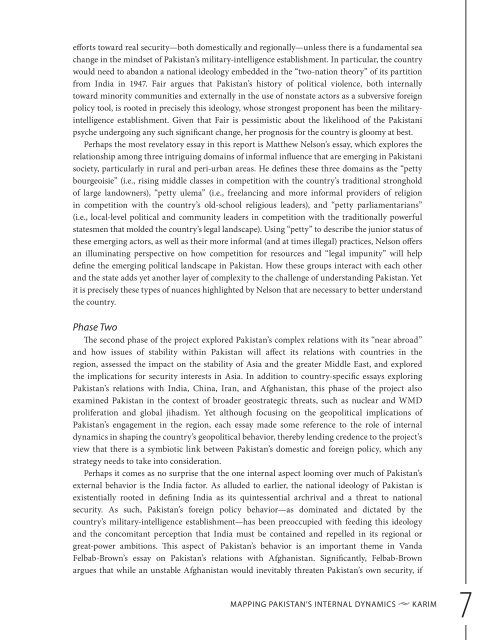pakistan’s
SR55_Mapping_Pakistan_February2016
SR55_Mapping_Pakistan_February2016
You also want an ePaper? Increase the reach of your titles
YUMPU automatically turns print PDFs into web optimized ePapers that Google loves.
efforts toward real security—both domestically and regionally—unless there is a fundamental sea<br />
change in the mindset of Pakistan’s military-intelligence establishment. In particular, the country<br />
would need to abandon a national ideology embedded in the “two-nation theory” of its partition<br />
from India in 1947. Fair argues that Pakistan’s history of political violence, both internally<br />
toward minority communities and externally in the use of nonstate actors as a subversive foreign<br />
policy tool, is rooted in precisely this ideology, whose strongest proponent has been the militaryintelligence<br />
establishment. Given that Fair is pessimistic about the likelihood of the Pakistani<br />
psyche undergoing any such significant change, her prognosis for the country is gloomy at best.<br />
Perhaps the most revelatory essay in this report is Matthew Nelson’s essay, which explores the<br />
relationship among three intriguing domains of informal influence that are emerging in Pakistani<br />
society, particularly in rural and peri-urban areas. He defines these three domains as the “petty<br />
bourgeoisie” (i.e., rising middle classes in competition with the country’s traditional stronghold<br />
of large landowners), “petty ulema” (i.e., freelancing and more informal providers of religion<br />
in competition with the country’s old-school religious leaders), and “petty parliamentarians”<br />
(i.e., local-level political and community leaders in competition with the traditionally powerful<br />
statesmen that molded the country’s legal landscape). Using “petty” to describe the junior status of<br />
these emerging actors, as well as their more informal (and at times illegal) practices, Nelson offers<br />
an illuminating perspective on how competition for resources and “legal impunity” will help<br />
define the emerging political landscape in Pakistan. How these groups interact with each other<br />
and the state adds yet another layer of complexity to the challenge of understanding Pakistan. Yet<br />
it is precisely these types of nuances highlighted by Nelson that are necessary to better understand<br />
the country.<br />
Phase Two<br />
The second phase of the project explored Pakistan’s complex relations with its “near abroad”<br />
and how issues of stability within Pakistan will affect its relations with countries in the<br />
region, assessed the impact on the stability of Asia and the greater Middle East, and explored<br />
the implications for security interests in Asia. In addition to country-specific essays exploring<br />
Pakistan’s relations with India, China, Iran, and Afghanistan, this phase of the project also<br />
examined Pakistan in the context of broader geostrategic threats, such as nuclear and WMD<br />
proliferation and global jihadism. Yet although focusing on the geopolitical implications of<br />
Pakistan’s engagement in the region, each essay made some reference to the role of internal<br />
dynamics in shaping the country’s geopolitical behavior, thereby lending credence to the project’s<br />
view that there is a symbiotic link between Pakistan’s domestic and foreign policy, which any<br />
strategy needs to take into consideration.<br />
Perhaps it comes as no surprise that the one internal aspect looming over much of Pakistan’s<br />
external behavior is the India factor. As alluded to earlier, the national ideology of Pakistan is<br />
existentially rooted in defining India as its quintessential archrival and a threat to national<br />
security. As such, Pakistan’s foreign policy behavior—as dominated and dictated by the<br />
country’s military-intelligence establishment—has been preoccupied with feeding this ideology<br />
and the concomitant perception that India must be contained and repelled in its regional or<br />
great-power ambitions. This aspect of Pakistan’s behavior is an important theme in Vanda<br />
Felbab-Brown’s essay on Pakistan’s relations with Afghanistan. Significantly, Felbab-Brown<br />
argues that while an unstable Afghanistan would inevitably threaten Pakistan’s own security, if<br />
MAPPING PAKISTAN’S INTERNAL DYNAMICS u KARIM<br />
7



